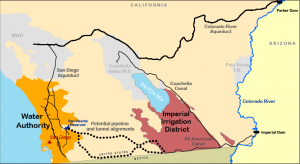
The Water Authority’s independent Colorado River water supplies are delivered through the Colorado River Aqueduct. The Water Authority is assessing potential pipeline and tunnel alignments that could move these supplies from Imperial Dam to San Vicente Reservoir. This map shows alternative routes for such a conveyance system.
The San Diego County Water Authority held a special board meeting on Thursday, Sept. 14, to hear information on an upcoming decision related to the future duration of the Water Transfer Agreement with the Imperial Irrigation District (IID) and the Exchange Agreement with the Metropolitan Water District of Southern California (MWD). While the initial term of the Transfer Agreement with IID is 45 years (through 2047), the Exchange Agreement to transport the transfer water has an initial term of 35 years (through 2037). The Water Authority has the unilateral option to either end the transfer 10 years early in 2037, or to extend the Exchange Agreement by 10 years to align with the Transfer Agreement. Both options expire at the end of 2017.
The meeting discussion included a proposed concept of building a pipeline from San Diego to the Imperial Valley as an alternative method of conveying conserved water under the transfer agreement with IID. This is not a new concept and studies dating back to the 1940s include similar alignments for a conveyance and all of the options discussed were updated from previous studies.
Staff presented three alternatives for a pipeline project between San Diego and the Imperial Valley. One would be an above-ground line that stretches from the San Vicente reservoir in San Diego to the western tail of the All-American Canal. The second would be an underground line that would connect to a parallel canal to the Westside Main Canal. A third option involves a joint binational conveyance system that would cross the international border into Mexico that would carry water west for both countries. Any option considered would have to go through an environmental review process and couldn’t move forward without an agreement between the Water Authority and IID.
Some historical reference is necessary. From the very start of the water transfers in 2003, the Water Authority has disputed the price MWD charges for transporting (or “wheeling”) water through its aqueduct, and those charges are the subject of unresolved litigation in state court. The Water Authority has petitioned the state Supreme Court to address whether MWD may add State Water Project supply costs to the price it charges to transport the Water Authority’s QSA supplies of Colorado River water through MWD’s aqueduct. While it is uncertain as to when the court will decide whether to take the case, the Water Authority board still faces a December deadline to vote on term length of the Transfer and Exchange Agreements.
The Water Authority continues to believe that the water transfer is a mutually beneficial agreement between the Water Authority and IID, and exploring alternatives that continue to support the transfer and by extension the Quantification Settlement Agreement is a worthwhile effort.
The items discussed were for information only. However, given the weight of the decision due at the end of 2017, the need to protect its member agencies, and the importance of the water transfer, the Water Authority believes all alternatives that uphold the transfer and the QSA should be discussed. The water transfer—back when it was approved and still today—is the critical component that allows the QSA to balance water use among the states that depend on the Colorado River.
If you have any questions on the pipeline discussions, the decision facing the Water Authority at the end of this year, or the Exchange Agreement between the Water Authority and MWD, contact Darren Simon at dsimon@sdcwa.org or at 760.337.1386.
For further information, see the Water Authority’s website here.
